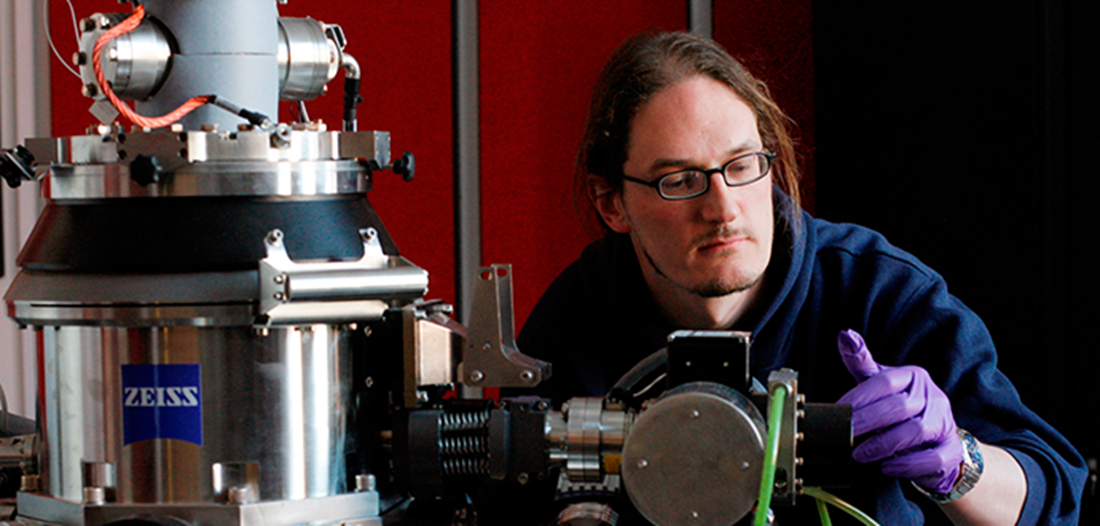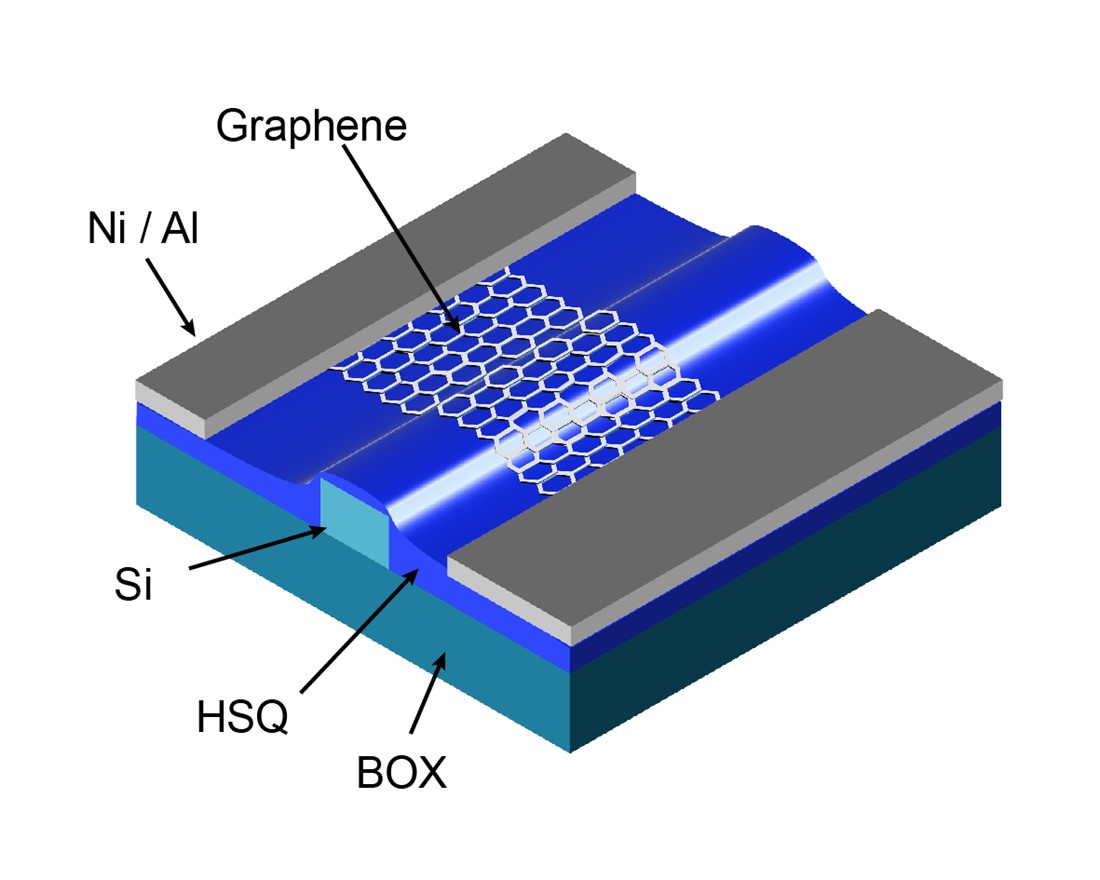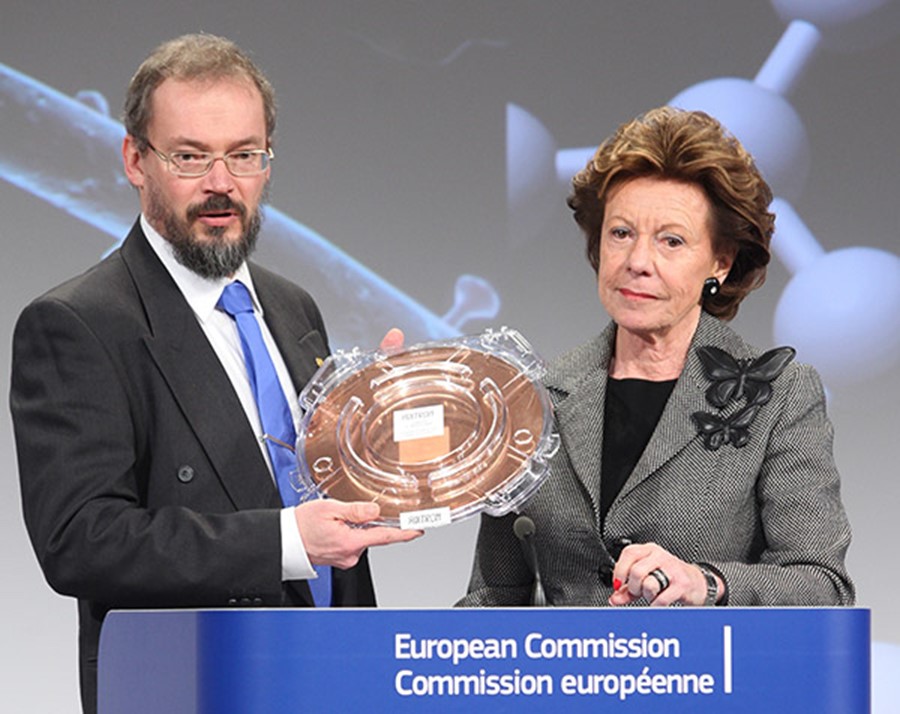The Graphene Flagship – one year on
In October 2013, the European Commission as part of its Future and Emerging Technologies scheme launched two FET flagships – the Human Brain Project, and the Graphene Flagship. These large scale, international research collaborations have been implemented initially as Seventh Framework Programme projects, with the longer term organisation within FP7′s successor research and innovation framework, Horizon 2020.
Here we focus on the Graphene Flagship, outline its background and organisation, celebrate achievements in the first year of operation, and look to the future.
Graphene – what and why?
Graphene is a two-dimensional material based on single atom-thick layers of carbon, with the carbon atoms arranged in a honeycomb-like lattice. This transparent, flexible material has a number of unique properties. For example, it is 100 times stronger than steel, and conducts electricity and heat with great efficiency.
A number of practical applications for graphene are currently being developed. These include flexible computer displays, sensors, medical and bioengineering technologies, filtration, super-strong composites, photovoltaics, and energy storage.
Graphene and beyond
The Graphene Flagship also covers other layered nanomaterials whose development was inspired by graphene. Graphene is just the first of hundreds of possible two-dimensional materials. The flagship plans to study these materials, and accelerate their journey from laboratory to factory floor.
Especially exciting is the possibility of stacking two-dimensional elements to create materials not found in nature, with properties tailored for specific applications. Such composite layered materials could be combined with other nanomaterials, such as metal nanoparticles, in order to further enhance their properties and uses.
Graphene – the fruit of European scientific excellence
Europe, North America and Asia are all active centres of graphene R&D, but Europe has special claim to be at the centre of this activity. The structure of graphite was first identified in Europe, and the first monolayer of the semiconducting two-dimensional material molybdenum disulphide was produced in Europe.
Most importantly, the ground-breaking experiments on graphene recognised in the award of the 2010 Nobel Prize in Physics were conducted by European physicists. It is European scientists and engineers who as part of the Graphene Flagship are closely coordinating research efforts, and accelerating the transfer of layered nanomaterials from the laboratory to factory floor.
EU-based researchers have made pioneering contributions to the science and technology of graphene and related materials. The areas in which they excel include material identification, optoelectronics, spintronics, large scale production, and sensors.
Manchester University scientists Andre Geim and Konstantin Novoselov shared the Nobel Prize for their work on graphene, and were then honoured in their adopted country with knighthoods. Since then, graphene research in Europe has continued apace, with major public funding for specialist centres, and the stimulation of academic-industrial partnerships devoted to this novel nanomaterial.
Why the Graphene Flagship?
The world’s premier research initiative devoted to graphene is Europe’s Graphene Flagship: a visionary, science-driven, academic-industrial partnership which addresses grand scientific and technological challenges related to graphene and similar two-dimensional nanomaterials.
The vision of the Graphene Flagship is long term, bringing together scientists and engineers from across various countries and academic disciplines, all of whom share a unifying goal, and an ambitious roadmap on how to achieve it. Underpinning the Graphene Flagship is a single-minded focus on a disruptive technology set to have a massive impact on human society.
Future and Emerging Technology Flagships – an overview
The Graphene Flagship and Human Brain Project are the product of a European Commission communication in 2009 which stressed the need for Europe to address the big scientific and technological challenges through long-term, multidisciplinary R&D efforts. In December 2009, the European Union’s Competitiveness Council welcomed the recommendation, and invited the Commission to create the first two flagships.
Graphene Flagship – partnership and growth
Following a three-year preparatory phase, the Graphene Flagship began life as an FP7 project, with 76 academic and industrial partners in 17 countries. Soon we will have 142 partners in 23 countries, with the 66 new partners invited to join the flagship following the results of a €9m competitive call. More than a third of the new members are commercial companies, and of the full consortium, some 27% of the partners are industrial.
The Graphene Flagship has a project cost of €1bn over 10 years, with half the money from the European Commission, and the remainder from other sources. We are currently in the 30 month, €54m ramp-up phase, which runs to the end of March 2016. Then we have the steady-state phase, under the Horizon 2020 programme, with expected EC funding of €50m per year.
Graphene Flagship organisation
The Graphene Flagship is divided into 16 work packages, 11 of which are devoted to specific science and technology themes, and the remaining five to project management, technology transfer and dissemination. Coordinating the project is a management team based at Chalmers University of Technology in Gothenburg. The director of the Graphene Flagship is nanomaterials physicist, Professor Jari Kinaret.
The Executive Board of the Graphene Flagship consists of the director, work package leaders and four additional members elected annually by the General Assembly. Board members come from eight European countries, and the current chairman is Professor Andrea Ferrari, head of the Cambridge Graphene Centre.
Supporting the secretariat and executive of the Graphene Flagship is a Strategic Advisory Council with experts drawn from academia and industry. Members of the council include two of the flagship’s four Nobel laureates.
First year highlights from the Graphene Flagship
The activities of all the flagship partners are too numerous to list in this brief introduction. Instead we highlight four notable achievements over the first year of operation, all of which have featured in the mainstream media.
Graphene production – a kitchen sink approach
Mass production of graphene at low cost is a priority when it comes to real-world applications and product development. A number of flagship partners are looking at the manufacture of high-quality graphene, and the tailoring of material properties for specific applications.

Jonathan Coleman’s low-dimensional nanostructures group at Trinity College Dublin has devised a way of producing large quantities of flawless graphene by separating graphite flakes in liquids with a rotating tool that works in much the same way as a kitchen blender. Such simple, creative science is the hallmark of the Professor Coleman’s team.
Flexible displays that can be rolled up in your pocket
Conventional silicon-based electronics are rigid, and for this reason you cannot roll up a current generation e-reader or tablet computer, and stuff it in your pocket. But flexible displays are being developed, some with graphene at their core.
Flexible electronics specialist Plastic Logic is a pioneer in this area. Together with flagship partner the Cambridge Graphene Centre, Plastic Logic recently demonstrated the world’s first flexible display with graphene incorporated into its pixel backplane. Combined with an electrophoretic imaging film, the result is a low-power, durable display suitable for use in many and various environments.
Fibre-optics data boost from graphene
Optical fibres form the backbone of terrestrial and trans-oceanic telecommunications systems. The carrying of huge volumes of data is limited by the ability with which photons are registered as they pass through the fibres, and the need is to record and store information efficiently and at high speed.

Schematic of an infrared photodetector with graphene as its active element (image: AMO GmbH)
Daniel Schall and a team of researchers at AMO in Aachen, and Alcatel-Lucent Bell Labs in Stuttgart, recently demonstrated photodetectors for infrared fibre-optic systems based on wafer-scale graphene. The devices have data rates of up to 50 gigabits per second, and display excellent signal integrity.
Rechargeable batteries with spreadable graphene ink
Vittorio Pellegrini and his colleagues at the Italian Institute of Technology in Genoa, University Sapienza of Rome and other research centres, have developed a graphene-based rechargeable battery of the lithium-ion type used in portable electronic devices.
Graphene is incorporated into the battery anode in the form of a spreadable ink containing a suspension of graphene nanoflakes. The battery displays a higher performance than conventional lithium-ion cells, with a 25% improvement in energy density.
Graphene inks are a particularly exciting area of research, owing to their low cost, ease of use and scalability.
Graphene Flagship – the next steps
The Graphene Flagship is off to a running start, with a dynamic, open and efficient management structure, and a network of productive research scientists, engineers and industrial partners collaborating to achieve well-defined common goals. At the same time, the flagship partners operate in a highly competitive environment, with all of them striving for excellence in their respective spheres.
We are nearing the end of our first year of operation, and in line with the label attached to the current funding period, the flagship is ramping up activities. We are also consolidating the research collaboration, management and communications structures, and taking stock of progress to date. Soon we shall be joined by 66 new partners, effectively doubling the size of the Graphene Flagship.
As European Commission Vice-President Neelie Kroes says,…
“Europe is leading the graphene revolution. This wonder material has the potential dramatically to improve our lives: it stimulates new medical technologies, such as artificial retinas, and more sustainable transport with light and ultra-efficient batteries. The more we can unlock the potential of graphene, the better!”
Unlocking the practical potential of graphene is our mission, and in Europe that is what we are doing in the Graphene Flagship.

Jari Kinaret, director of the Graphene Flagship, with European Commission Vice-President Neelie Kroes
Europe is leading the graphene revolution. This wonder material has the potential dramatically to improve our lives: it stimulates new medical technologies, such as artificial retinas, and more sustainable transport with light and ultra-efficient batteries. The more we can unlock the potential of graphene, the better!”
European Commission Vice-President



